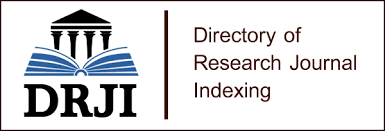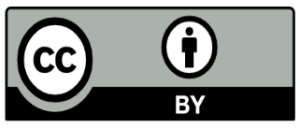UTILIZATION OF CYBERSPACE BY TERRORIST GROUPS AND THE APPLICABILITY OF THE MALAYSIAN LAW ON TERRORISM
Abstract
It is an obvious and undeniable fact, that the cyberspace is become a powerful method which is increasingly and quickly utilized by terrorist organizations to achieve their gruesome and nefarious goals by hitting innocent individuals. This paper has conducted a critical and comprehensive study on the literature review aiming to answer several inquiries about utilization of cyberspace by terrorist groups and the applicability of  Malaysian law on terrorism. The meaning, characteristics and goals of cyber terrorism will be highlighted. Furthermore, this paper will clarify how terrorist groups invade the cyberspace with highlighting on “ISIS†as an example. In addition, this paper will indicate how the Malaysian Law addresses the terrorism. This paper has proved that the terrorist groups become more sophisticated and complex by adopting the cyberspace. Moreover, this paper discloses how terrorist groups exploit the cyberspace. Even if, Malaysian law adopts many measures and precautions to counter terrorism, but, it still needs more efforts to deal with terrorism, by regulating the “Bitcoinsâ€, introducing a clear definition about the meaning of "lethal device†to encompass harm programs and viruses, and distinguishing between clicking "like" or sharing the terrorist items with use explicit words to glorify the terrorism and without use any explicit glorification words. The lawgiver must take into consideration the possession of terrorist items or publications for academic and innocent purposes. Finally, under SOSMA, the power to intercept the communications must be subjected on the judicial oversight and the power of arrest must be based on objective test.
References
Awan, I. (2014). Debating the Term Cyber-terrorism: issues and problems. Internet Journal of Criminology. ISSN 2045 6743. Pp. 1-14.â€
Ahmed, S. (2015). Who were Syed Rizwan Farook and Tashfeen Malik?. CNN. <http://edition.cnn.com/2015/12/03/us/syed-farook-tashfeen-malik-mass-shooting-profile>. Accessed on: 25/3/2016
Al Bar qËw qÊy, M. (2015). bÊytkËwen wa al dyÊnal al dhÉhabËy hal yandÉmj daÉÑsh fÊy al mËjtamÑ al dËwaly?. Masr alarabia. <http://www.masralarabia.com Accessed on: 27/2/2016
Brantly, A. (2014). Financing terror bit by bit. Compating terrorism center. <https://www.ctc.usma.edu/posts/financing-terror-bit-by-bit>. Accessed on: 14/3/2016
Bernama. (2015). Soldier gets 7 months' jail for IS image on mobile phone. malaysia kini. <https://www.malaysiakini.com/news/316470>. Accessed on: 4-3- 2016.
Bertrand, N. (2015). ISIS is taking full advantage of the darkest corners of the internet. Business insider. <http://www.businessinsider.my/isis-is-using-the-dark-web-2015-7/? r=US&IR=T#Xg01BPcbqoY4EWqA.97>. Accessed on: 27/2/2016
Borneo. (2015). Five individuals nabbed for terrorism activities. The Borneo Post. <http://www.theborneopost.com/2015/12/06/five-individuals-nabbed-for-terrorism-activities/#ixzz429HY8dlS>. Accessed on: 24/3/2016
Baron, B. F. (2004). Deterring donors: Anti-terrorist financing rules and American philanthropy. International Journal of Not-for-Profit Law. Vol. 6. No.2. Pp.1-32.â€
Barakat,I. (2014). IS: Islamic social media state of mind. Alaraby. <https://www.alaraby.co.uk/english/politics/2014/11/15/is-islamic-social-media-state-of-mind>. Accessed on: 12/3/2016.
BawaÉdy, ×. (2006). ÑrhaÉb al alaÑntarnt al khaÃar al qaÉdÊm. daÉr maÃŽyr. ÃabÑa al ÑËwlaÉ.
CBC News. (2015). ISIS has a magazine - what we can learn from Dabiq: Top Stories. CBC News. <http://www.cbc.ca/news/canada/hamilton/news/isis-has-a-magazine-what-we-can-learn-from-dabiq-top-stories-1.3336005>. Accessed on: 24/2/2016
Calmaur, K. (2016). Apple vs. the. FBI. The Atlantic. <http://www.theatlantic.com/national/archive/2016/02/apple-fbi-san-bernardino/463128>. Accessed on: 21/3/2016
Crethiplethi. (2014). ISIS’s Propaganda Machine. Crethiplethi. < http://www.crethiplethi.com/isis-s-propaganda-machine/islamic-countries/syria-islamic-countries/2015/>. Accessed on: 14/3/2016
Conway, M. (2006). Terrorism and the Internet: new media—new threat?. Parliamentary Affairs. Vol. 59. No. 2. Pp. 283-298.â€
Drifter. (2004). Modern Hawala. How to vanish. <http://www.howtovanish.com/2009/09/modern-hawala>. Accessed on: 15/2/2016
Dearden. L. (2016). Isis supporters threaten UK with terror attacks in new propaganda video. independent. <http://www.independent.co.uk/news/uk/home-news/isis-supporters-threaten-london-with-terror-attacks-in-new-propaganda-video-a6969006.html>. Accessed on:4-6-2016
Dhanapal, S., Sabaruddin, J. S. (2015). Rule of law an initial analysis of security offences (Special Measures) Act (SOSMA) 2012. IIUM Law Journal. Vol.23. No. 1. Pp. 1-29â€
Eshpar, Y., Baram, G., Averbuch, A., Siboni, G., Cohen, D., Rotbart, A., Crosston. (2013). the Threat of Terrorist Organizations in Cyberspace. Military and Strategic Affairs. Vol. 5. No. 3, 2013, pp. 127-144
Edelman, J. (2014). How Social Media is Being Used for Terrorism. Site pro news. <http://www.sitepronews.com/2014/09/22/social-media-used-terrorism>. Accessed on: 12/2/2016.
Faith, D. C. (2011). The hawala system. Global Security Studies. Vol. 2. No. 1. Pp. 24-33
Fox News. (2014). Google Play store reportedly removes ISIS app. Fox News. <http://www.foxnews.com/tech/2014/06/19/google-play-store-removes-isis-app.html>. Accessed on: 23/2/2016.
Furnell, S. M., & Warren, M. J. (1999). Computer hacking and cyber terrorism: The real threats in the new millennium?. Computers & Security. Vol. 18. No. 1. Pp. 28-34
Goodman, S. E., Kirk, J. C., & Kirk, M. H. (2007). Cyberspace as a medium for terrorists. Technological Forecasting and Social Change. Vol. 74. No. 2. Pp. 193-210.â€
Gunaratnam, S. (2016). Court reminds Malaysians to desist IS during ex-govt servant's sentencing. New straits.<http://www.nst.com.my/news/2016/03/135132/court-reminds-malaysians-desist-during-ex-govt-servants-sentencing>. Accessed on: 4-3-2016
Greenberg, A. (2014). Hacher lexicon what is the dark web?. Wired. <http://www.wired.com/2014/11/hacker-lexicon-whats-dark-web>. Accessed on: 12/3/2016
Hill, G. (2015). Cyber Caliphate Attacks Malaysia Airlines Website. Security today. <https://securitytoday.com/articles/2015/01/26/cyber-caliphate-attacks-malaysia-airlines-website.aspx?admgarea=ht.airport>. Accessed on: 27/2/2016
Hayward, J. (2015). Mystery Gunmen Attack ISIS Radio Station in Mosul. breitbart. <http://www.breitbart.com/national-security/2015/08/31/mystery-gunmen-attack-isis-radio-station-in-mosul/>. Accessed on: 19/3/2016
Harding, T. (2007). Terrorist use Google map to hit UK troops. Telegraph. <http://www.telegraph.co.uk/news/worldnews/1539401/Terrorists-use-Google-maps-to-hit-UK-troops.html>. Accessed on: 19/3/2016
Halkon, R. (2015). Paris attacks: ISIS terrorists may have used PlayStation 4s to plot atrocities. Mirror. <http://www.mirror.co.uk/news/world-news/paris-attacks-isis-terrorists-used-6836462>. Accessed on: 22/3/2016
Jost, P. M., & Sandhu, H. S. (2003). The hawala alternative remittance system and its role in money laundering. Interpol.†the Financial Crimes Enforcement Network in cooperation with INTERPOL/FOPAC
Kennedy - Pipe, C., Clubb, G., & Mabon, S. (2015). Terrorism and political violence. London: Sage.â€
Lamothe, D. (2015). U.S. military social media accounts apparently hacked by Islamic State sympathizers. Washington post. <https://www.washingtonpost.com/news/checkpoint/wp/2015/01/12/centcom-twitter-account-apparently-hacked-by-islamic-state-sympathizers>. Accessed on: 28/2/2016
Leswing, K. (2016). Over half of Americans think Apple should unlock the San Bernardino shooter’s iPhone. Business Insider. <http://www.businessinsider.my/over-half-of-americans-think-apple-should-unlock-san-bernardino-iphone-2016-2/#CPLIpf791Ex4w4id.99>. Accessed on: 19/3/2016
Lewis, J. A. (2002). Assessing the risks of cyber terrorism, cyber war and other cyber threats. Center for Strategic & International Studies.†pp. 1-12
Minei, E., & Matusitz, J. (2012). Cyberspace as a new arena for terroristic propaganda: an updated examination. Poiesis and Praxis. Vol. 9. No.1. Pp.163-176.â€
QÉÃtaÉnyÊ, M., QÉÃtaÉnyÊ, M. (2014). Al qËwaÊ al khÉfyÊÉ lÊ daÉÑsh fÊy al’aÑlÉm al jadÊed. jaÉmÊÑt al malÊk sËÑwd.
Rouse, M. (2013). Definition of Bitcoin. Tech target. <http://whatis.techtarget.com/definition/Bitcoin>. Accessed on: 15/3/2016
SafÊr, ×. (2013). Al ’rhaÉb wa alÑËnf fÊy mËyzaÉn al sharÊÑh al ’slamÊyÉh wa al qaÉnwËn al ÑËwlaÉ. Dar al daËwha. qaÃar.
Sario, U, S. (2013). Lahad Datu: Eight charged in Tawau High Court over Sabah incursion. The Star. <http://www.thestar.com.my/news/nation/2013/03/21/lahad-datu-eight-charged-in-tawau-high-court-over-sabah-incursion-updated>. Accessed on: 24/3/2016
Siboni, G., Cohen, D., & Koren, T. †(2015). The Islamic State’s Strategy in Cyberspace. Military and Strategic Affairs. Vol. 7. No. 1, 2015, pp. 3-29
Shandra. (2012). History of cyber terrorism. Blog. <http://cyberterrorismlaw.blogspot.my/2012/03/history.html>. Accessed on: 18/3/2016
Simon, W. (2014). The operation of the security offences (special measure) acts 2014 and comparison with old internal security act 1948. herading a new democratic era or old win in a new bottle?. International Journal of Technical Research and Applications. www.ijtra.com Special Issue. e-ISSN: 2320-8163. Pp 78-83.
Trowbridge, A. (2014). "ISIS swiping hashtags as part of propaganda efforts". Computer business review. <http://www.cbsnews.com/news/isis-hijacks-unrelated-hashtags-in-attempt-to-spread-message>. Accessed on: 25/2/2016
Theohary, C. A. (2011). Terrorist use of the internet: Information operations in cyberspace. Washington. DIANE Publishing. March 8, 2011.
Veerasamy, N. (2009). Towards a Conceptual Framework for Cyber-terrorism. 4th International Conference on Information Warfare and Security. Cape Town, South Africa. 26-27 March 2009. pp 10.
Weimann, G. (2004). www. terror. net: How modern terrorism uses the Internet. United States
Institute of Peace . Vol. 31. No. 11. Pp. 1-11.
Weimann, G. (2014). New Terrorism and New Media. Wilson Center Common Labs.â€Vol. 2. Pp. 1-17.
WazaÉrt Al ’wqaÉf Al SwËrehÊ. (2014). Al ÑrhaÉb al ’alkÊtrËwny al thawËabit wa al motaghÊyraÉt. baÑath baÉrtÊ. < http://www.baathparty.sy/arabic/index.php?node=552&cat=1296&>. Accessed on: 3/1/2016
’aesar ÑaÃeÊh. (2014). Al Gra’m FÊe Úil Al MotÉgheÊrÉt Wa AlmotahawÊlÉt Al ÉqleÊmÉa Wa Al dwËÉleÊa,
Published
How to Cite
Issue
Section
License
Copyrights for articles published in Journal of Asian and African Social Science and Humanities are retained by the authors, with first publication rights granted to the journal. The journal/publisher is not responsible for subsequent uses of the work. It is the author's responsibility to bring an infringement action if so desired by the author.
Articles published in Journal of Asian and African Social Science and Humanities are published under the Creative Commons Attribution (CC-BY) license, which permits others to distribute, remix, tweak, and build upon your work as long as they credit you for the original creation.
Â














